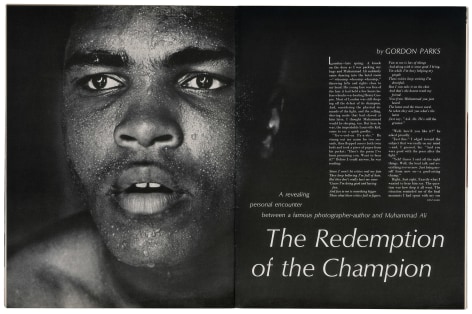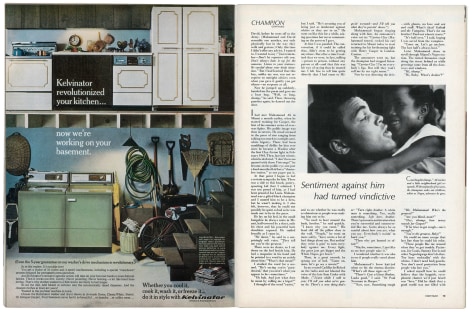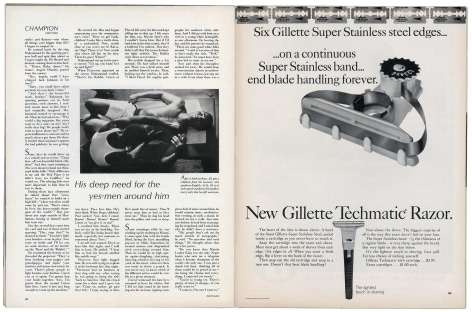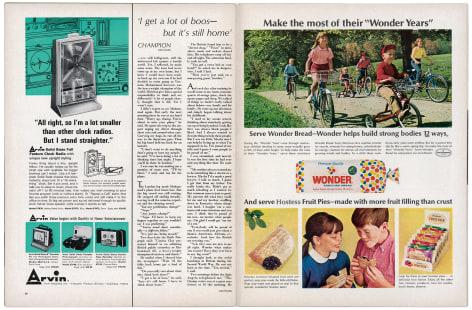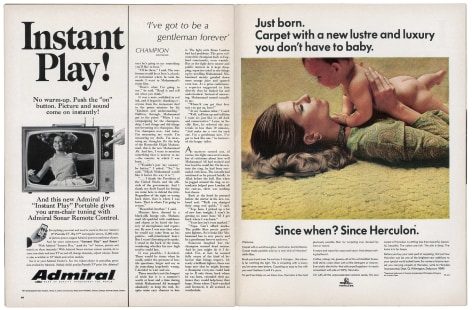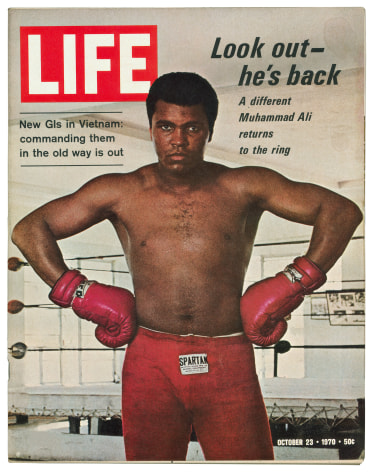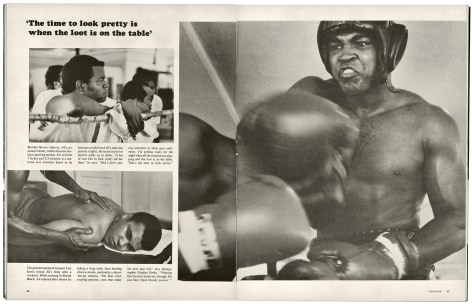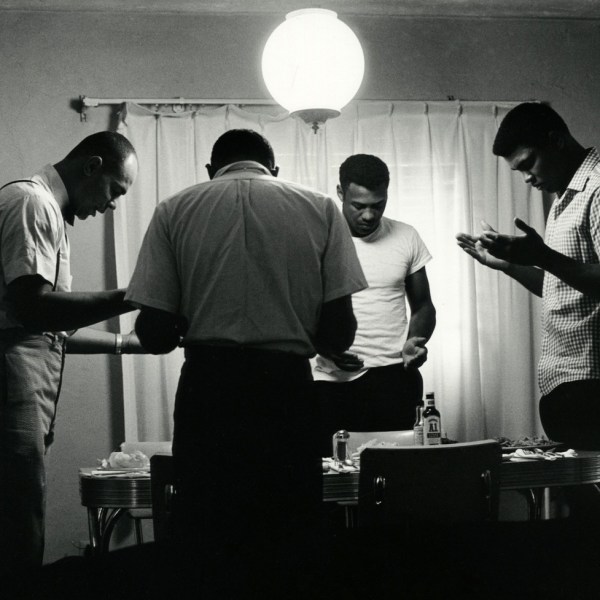
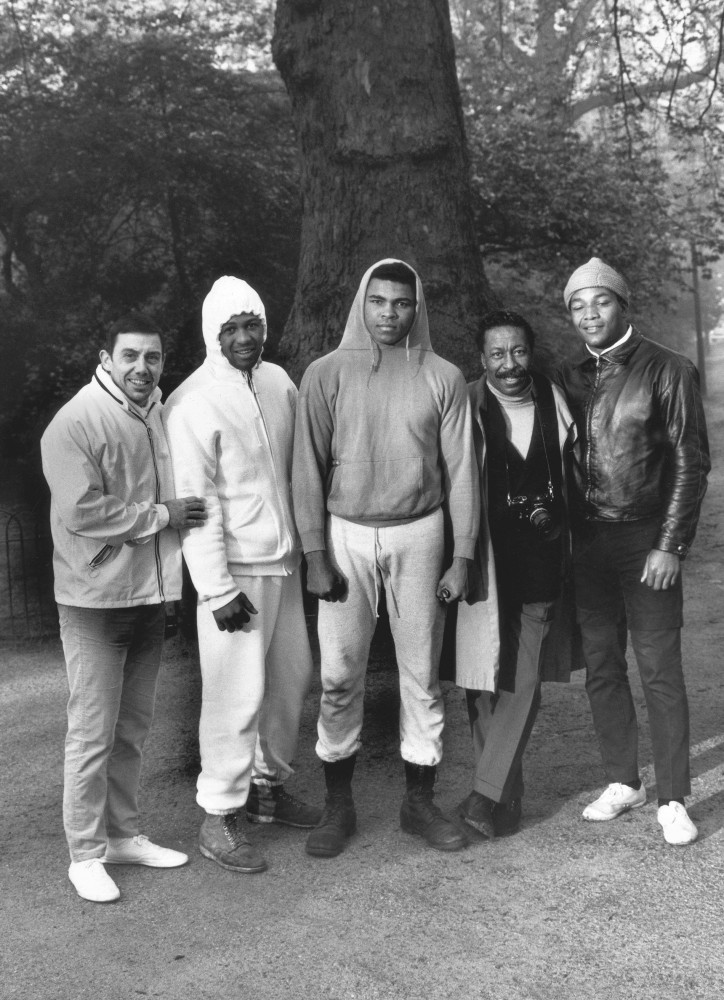
Photographer Unknown, Muhammad Ali, Gordon Parks, and others (right to left,
Angelo Dundee, Jimmy Ellis, Jim Brown), Hyde Park, London, England, 1966
Of all the portraits taken by Parks, perhaps none is as stunning as the close-up of Muhammad Ali, emerging mottled with sweat from a shadowy background. The essay this image introduced appeared in the September 9, 1966 issue of Life, at a time when Ali was embattled both in and out of the boxing ring.
Born Cassius Marcellus Clay, Jr., in 1942, Ali had become an international celebrity after winning a gold medal at the 1960 Summer Olympics in Rome. Over the next few years, he achieved prodigious success as a professional and then took the world heavyweight title from Sonny Liston in a dramatic fight in 1964. Soon after, inspired by his friendship with Black Muslim leaders Malcolm X and Elijah Muhammad, he converted to Islam and changed his name to Muhammad Ali, thus becoming the center of an intense national controversy. He was castigated for anti-white sentiments and for declaring himself a conscientious objector to the Vietnam War (on grounds that his religion forbade him to fight in this conflict).
Amid the uproar, Parks met Ali in Miami, where the champ was training. Accompanying him to London for his next fight, Parks crafted a psychological portrait of Ali that most Americans might never have imagined. While Ali came off as supremely confident, even arrogant, in his public appearances, Parks bore witness to his courtesy and charm. “The Redemption of the Champion” sought to rehabilitate Ali’s image by showing the human side of the smooth-talking fleet-footed boxer. It contained anecdotes about Ali’s patience, and quotations that revealed his concern for the opinion of others, especially the African Americans who lionized him.
The article was tremendously popular and helped redefine Ali’s career. It was also the beginning of a long relationship between the photographer and the fighter. Four years later, in 1970, Parks profiled Ali again—this time as he was attempting to win back his world heavyweight crown from Joe Frazier. Alluding to the photograph of a sweaty, intensely focused Ali that had introduced the 1966 article, this story opened with a close-cropped portrait of Ali in near-profile as he perspired from the exertion of a workout. The essay’s epigraph—“Dripping with controversy, Muhammad Ali comes back”—also recalls the earlier portrait.
While the initial images in the 1970 article express the ferocity the 28-year-old boxer brought to his training, Parks again evinced sympathy for Ali through disarming images of him glancing wide-eyed in the locker room, posing surrounded by young fans in a Miami restaurant, and taking a mid-afternoon nap after training.
Trainer Works on Muhammad Ali’s Shoulder, Miami Beach, Florida, 1966
Muhammad Ali, Miami Beach, Florida, 1966
Untitled, Miami Beach, Florida, 1966
Muhammad Ali Trains in Hyde Park, London, England, 1966
Untitled, London, England, 1966
Untitled, London, England, 1966
Muhammad Ali Fights Henry Cooper, London, England, 1966
Untitled, Miami, Florida, 1966
Untitled, Miami, Florida, 1966
Muhammad Ali Interviewed by Reporters, London, England, 1966
Untitled, Miami, Florida, 1970
Untitled, Miami Beach, Florida, 1970

